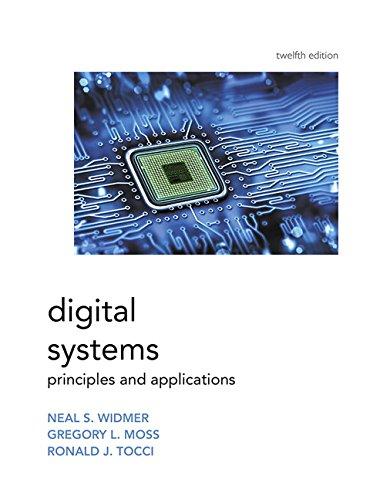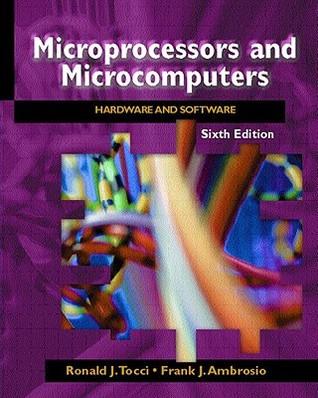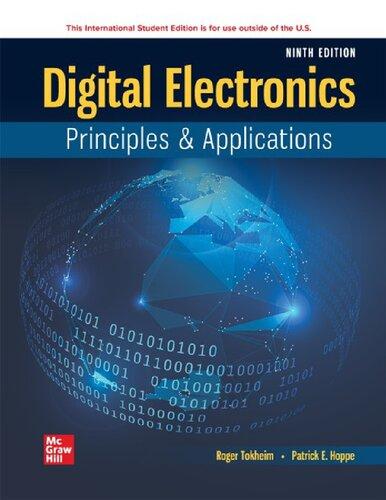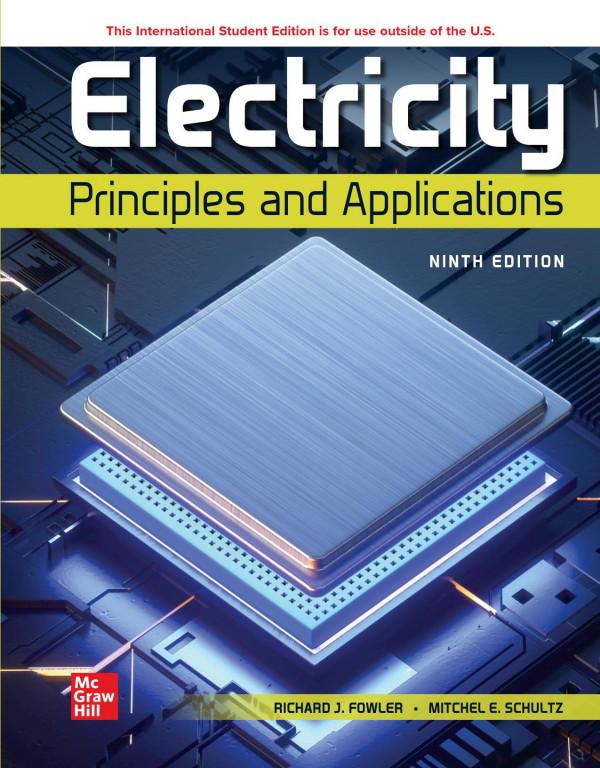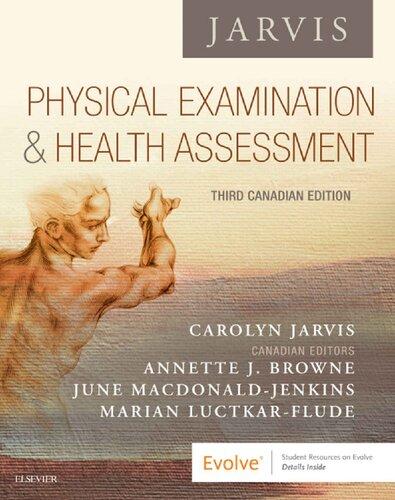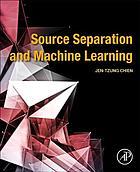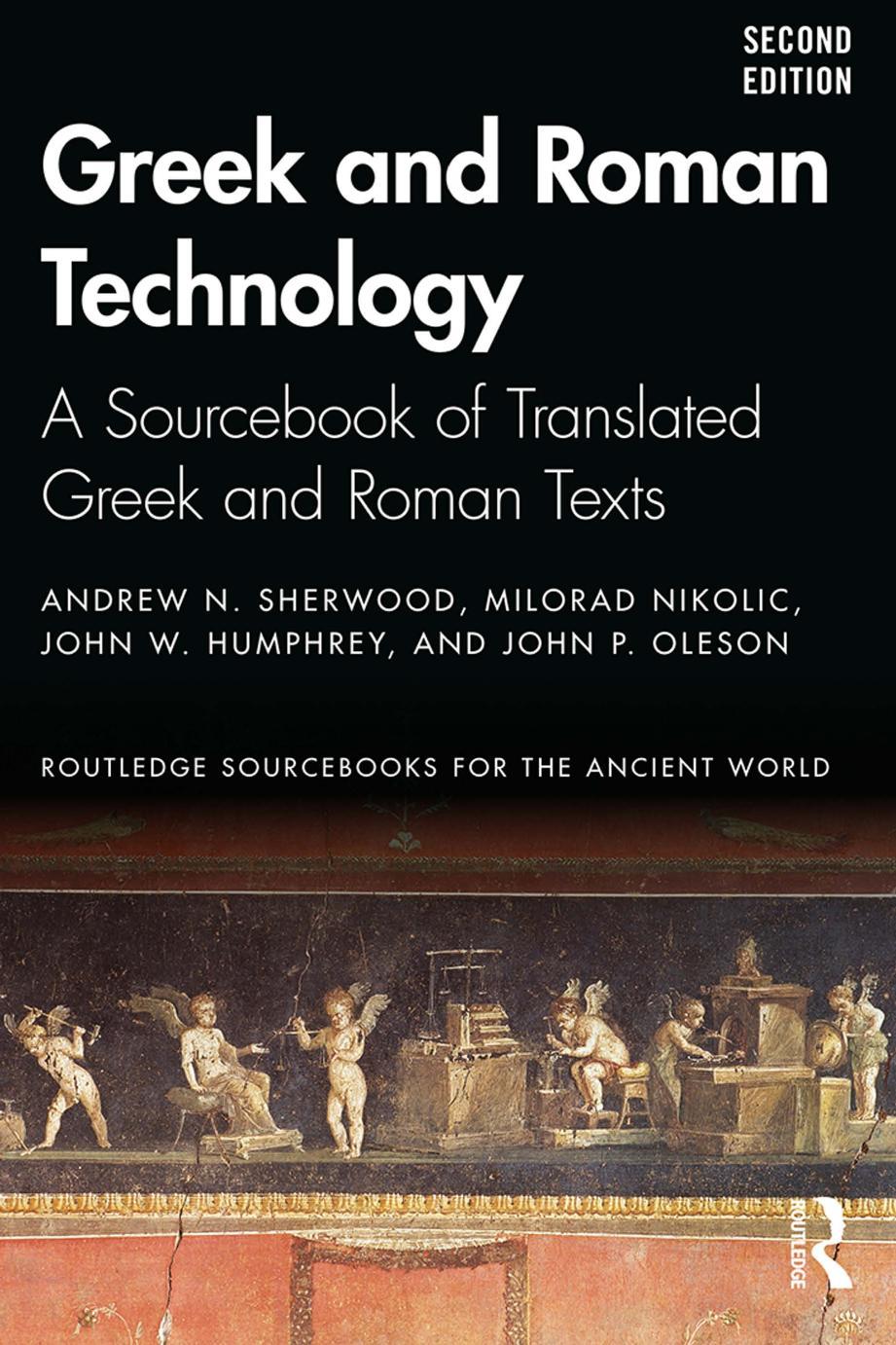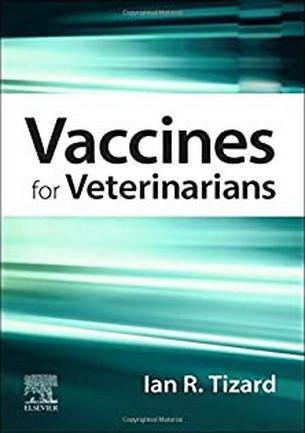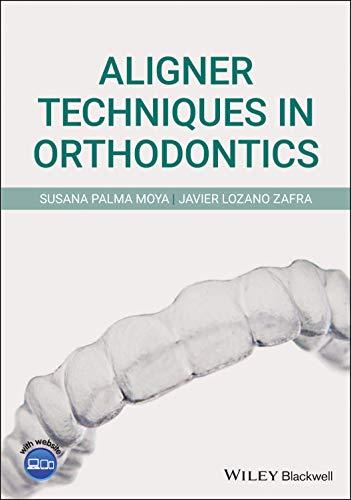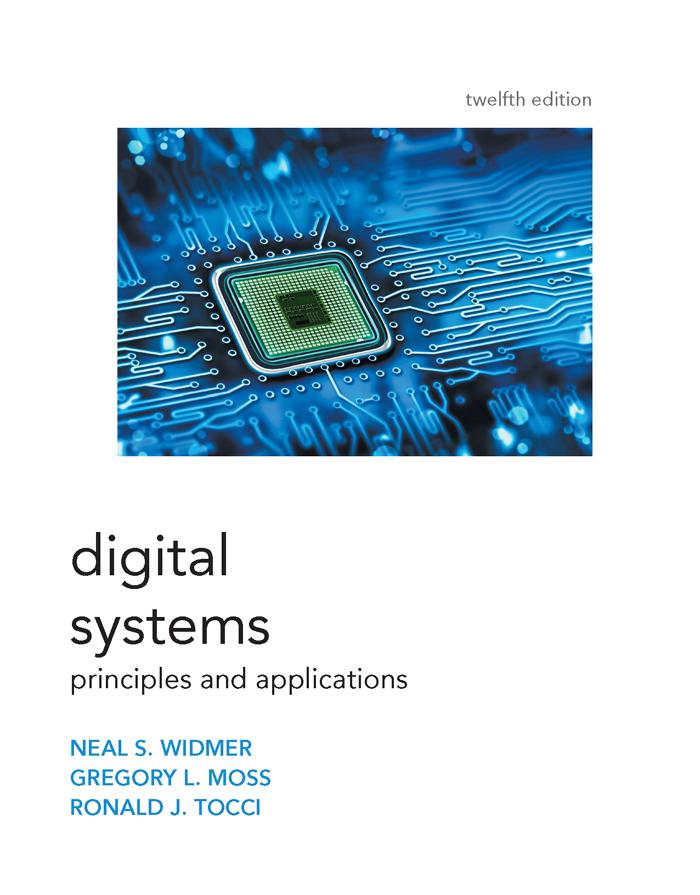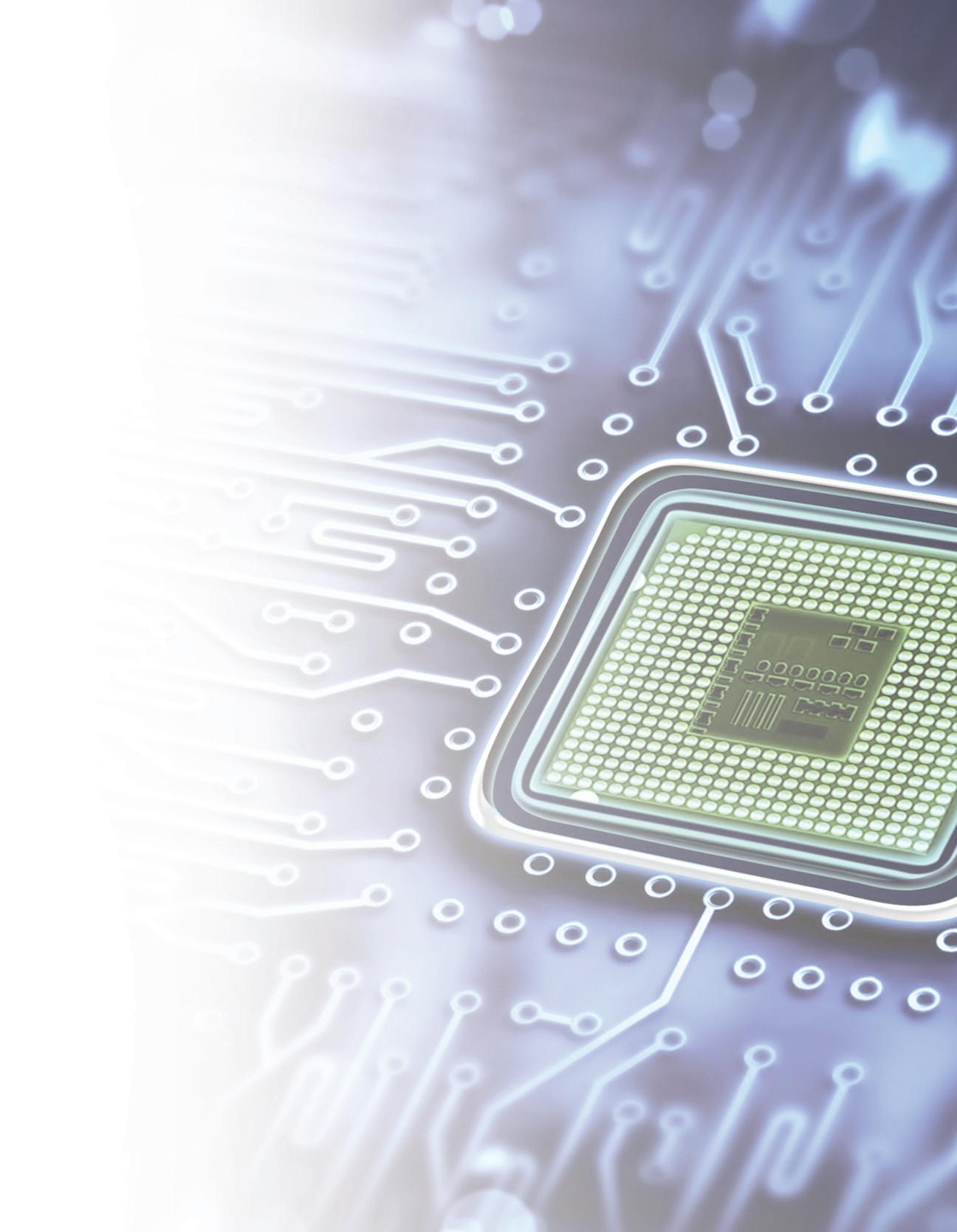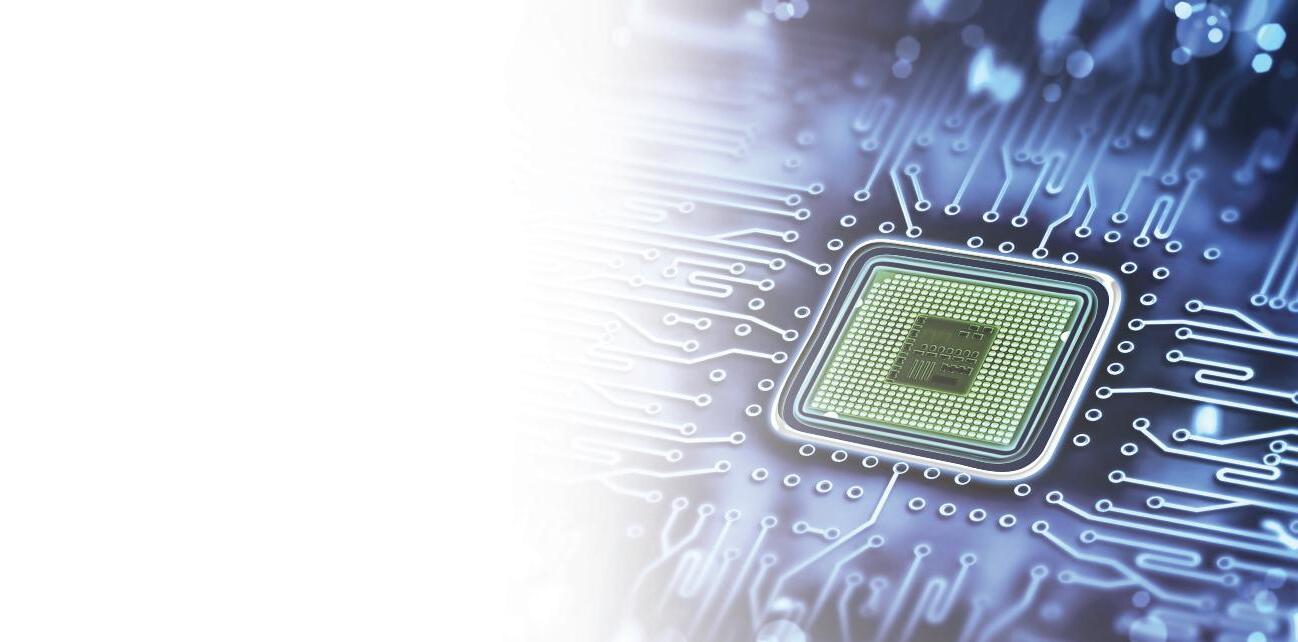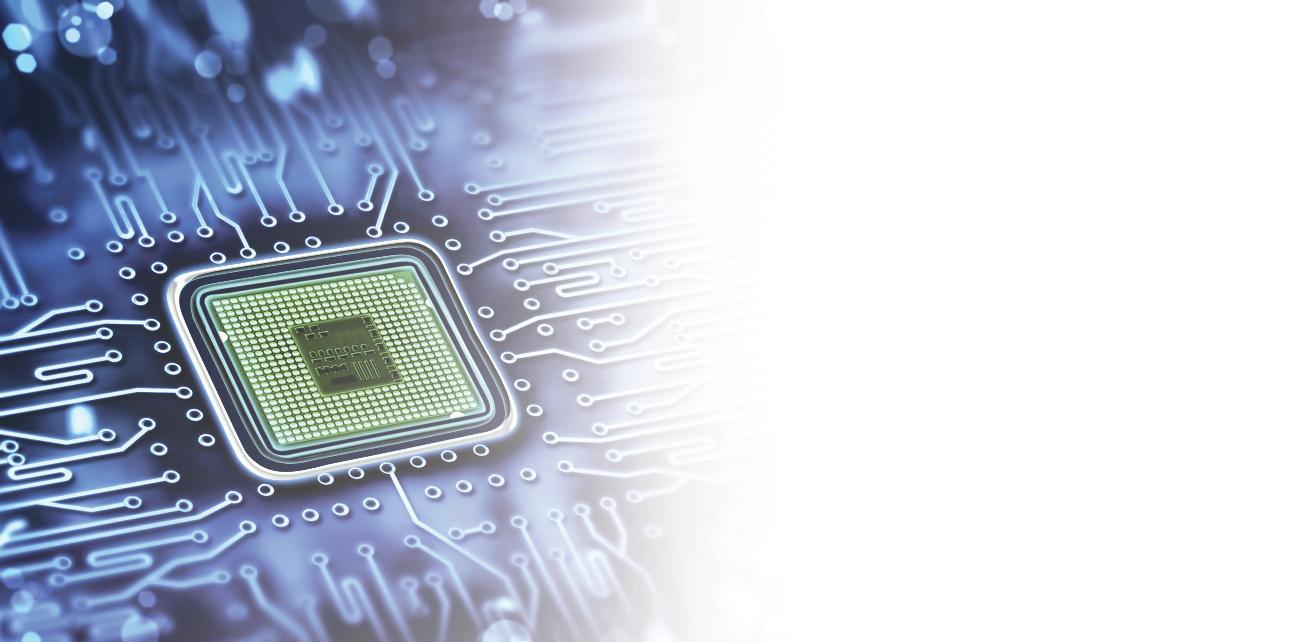Digital
Systems Principles and Applications
neal S. widmer
Purdue University
Gregory l. Moss Purdue University
Ronald J. Tocci
Monroe Community College
Editor-in-Chief: Andrew Gilfillan
Product Manager: Anthony Webster
Program Manager: Holly Shufeldt
Project Manager: Rex Davidson
Editorial Assistant: Nancy Kesterson
Team Lead Project Manager: Bryan Pirrmann
Team Lead Program Manager: Laura Weaver
Director of Marketing: David Gesell
Senior Product Marketing Manager: Darcy Betts
Field Marketing Manager: Thomas Hayward
Procurement Specialist: Deidra M. Skahill
Creative Director: Andrea Nix
Art Director: Diane Y. Ernsberger
Cover Designer: Cenveo
Full-Service Project Management: Philip Alexander/Integra Software Services, Pvt, Ltd.
Printer/Binder: R.R. Donnelley
Unless otherwise indicated herein, any third-party trademarks that may appear in this work are the property of their respective owners and any references to third-party trademarks, logos or other trade dress are for demonstrative or descriptive purposes only. Such references are not intended to imply any sponsorship, endorsement, authorization, or promotion of Pearson’s products by the owners of such marks, or any relationship between the owner and Pearson Education, Inc. or its affiliates, authors, licensees or distributors.
Copyright © 2017 by Pearson Education, Inc. or its affiliates. All Rights Reserved. Printed in the United States of America. This publication is protected by copyright, and permission should be obtained from the publisher prior to any prohibited reproduction, storage in a retrieval system, or transmission in any form or by any means, electronic, mechanical, photocopying, recording, or otherwise. For information regarding permissions, request forms and the appropriate contacts within the Pearson Education Global Rights & Permissions department, please visit www.pearsoned.com/permissions/.
Library of Congress Cataloging-in-Publication Data
Names: Tocci, Ronald J., author. | Widmer, Neal S., author. | Moss, Gregory L., author.
Title: Digital systems: principles and applications/Neal S. Widmer, Purdue University, Ronald J. Tocci, Monroe Community College, Gregory L. Moss, Purdue University.
Description: Twelfth edition. | Upper Saddle River [New Jersey]: Pearson, [2017] | Tocci’s name appears first in earlier editions.
Identifiers: LCCN 2016007313 | ISBN 9780134220130
Subjects: LCSH: Digital electronics.
Classification: LCC TK7868.D5 T62 2017 | DDC 621.381—dc23 LC record available at http://lccn.loc.gov/2016007313
10 9 8 7 6 5 4 3 2 1
ISBN 10: 0-13-422013-7
ISBN 13: 978-0-13-422013-0 www.pearsonhighered.com
Preface
This book is a comprehensive study of the principles and techniques of modern digital systems. It teaches the fundamental principles of digital systems and covers thoroughly both traditional and modern methods of applying digital design and development techniques, including how to manage a systemslevel project. The book is intended for use in two- and four-year programs in technology, engineering, and computer science. It can also be used for High School STEM education courses in these topical areas. Although a background in basic electronics is helpful, most of the material requires no electronics training. Portions of the text that use electronics concepts can be skipped without adversely affecting the comprehension of the logic principles.
What’s New in This Edition?
The following list summarizes the improvements in the twelfth edition of Digital Systems. Details can be found in the section titled “Specific Changes” on page ix.
Every section of every chapter now has a short list of expected outcomes for that section.
Chapter 1 has been revised extensively in response to feedback from users. New material on troubleshooting prototype circuits using systematic fault isolation techniques applied to digital logic circuits has been added to Section 4-13.
Quadrature Shaft Encoders used to obtain absolute shaft position serve as a real example of flip-flop applications, and timing limitations.
More material has been added to better explain the behavior of VHDL data objects and how they are updated in sequential processes.
Throughout the text, obsolete technology has been deleted or abbreviated to provide only content appropriate to modern systems. More modern examples are used as needed.
Some new problems have been added and outdated problems have been removed.
General Features
In industry today, getting a product to market very quickly is important. The use of modern design tools, CPLDs, and FPGAs allows engineers to progress from concept to functional silicon very quickly. Microcontrollers have taken over many applications that once were implemented by digital circuits, and DSP has been used to replace many analog circuits. It is amazing that microcontrollers, DSP, and all the necessary glue logic can now be consolidated onto a single FPGA using a hardware description language with advanced development tools. Today’s students must be exposed to these modern tools, even in an introductory course. It is every educator’s responsibility to find the best way to prepare graduates for the work they will encounter in their professional lives.
The standard SSI and MSI parts that have served as “bricks and mortar” in the building of digital systems for over 40 years are now obsolete and becoming less available. Many of the techniques that have been taught over that time have focused on optimizing circuits that are built from these outmoded devices. The topics that are uniquely suited to applying the old technology but do not contribute to an understanding of the new technology are being de-emphasized. From an educational standpoint, however, these small ICs do offer a way to study simple digital circuits, and the wiring of circuits using breadboards is a valuable pedagogic exercise. They help to solidify concepts such as binary inputs and outputs, physical device operation, and practical limitations, using a very simple platform. Consequently, we have chosen to continue to introduce the conceptual descriptions of digital circuits and to offer examples using conventional standard logic parts. For instructors who continue to teach the fundamentals using SSI and MSI circuits, this edition retains those qualities that have made the text so widely accepted in the past. Many hardware design tools even provide an easy-to-use design entry technique that will employ the functionality of conventional standard parts with the flexibility of programmable logic devices. A digital design can be described using a schematic drawing with pre-created building blocks that are equivalent to conventional standard parts, which can be compiled and then programmed directly into a target PLD with the added capability of easily simulating the design within the same development tool.
We believe that graduates will actually apply the concepts presented in this book using higher-level description methods and more complex programmable devices. The major shift in the field is a greater need to understand the description methods, rather than focusing on the architecture of an actual device. Software tools have evolved to the point where there is little need for concern about the inner workings of the hardware but much more need to focus on what goes in, what comes out, and how the designer can describe what the device is supposed to do. We also believe that graduates will be involved with projects using state-of-the-art design tools and hardware solutions.
This book offers a strategic advantage for teaching the vital topic of hardware description languages to beginners in the digital field. VHDL is undisputedly an industry standard language at this time, but it is also very complex and has a steep learning curve. Beginning students are often discouraged by the rigorous requirements of various data types, and they struggle with understanding edge-triggered events in VHDL. Fortunately, Altera offers AHDL, a less demanding language that uses the same basic concepts as VHDL but is much easier for beginners to master. So, instructors can opt to use AHDL to teach introductory students or VHDL for more advanced classes. This edition offers more than 40 AHDL examples, more than 40 VHDL examples, and many examples of simulation testing. All of these design files are available on the website (http://www.pearsonhighered.com/careersresources/).
Altera’s software development system is Quartus II. The material in this text does not attempt to teach a particular hardware platform or the details of using a software development system. We have chosen to show what this tool can do, rather than train the reader how to use it.
Many laboratory hardware options are available to users of this book. Complete development boards are available that offer the normal types of inputs and outputs like logic switches, pushbuttons, clock signals, LEDs, and 7-segment displays. Many boards also offer standard connectors for readily available computer hardware, such as a standard keyboard, computer mouse, VGA video monitor, COM ports, audio in/out jacks, plus two 40-pin general-purpose I/O ribbon connectors that allow connection to any digital peripheral hardware.
Our approach to HDL and PLDs gives instructors several options:
1. The HDL material can be skipped entirely without affecting the continuity of the text.
2. HDL can be taught as a separate topic by skipping the material initially and then going back to the last sections of Chapters 3, 4, 5, 6, 7, and 9 and then covering Chapter 10.
3. HDL and the use of PLDs can be covered as the course unfolds— chapter by chapter—and woven into the fabric of the lecture/lab experience.
Among all specific hardware description languages, VHDL is clearly the industry standard and is most likely to be used by graduates in their careers. We have always felt that it is a bold proposition, however, to try to teach VHDL in an introductory course. The nature of the syntax, the subtle distinctions in object types, and the higher levels of abstraction can pose obstacles for a beginner. For this reason, we have included Altera’s AHDL as the recommended introductory language for freshman and sophomore courses. We have also included VHDL as the recommended language for more advanced classes or introductory courses offered to more mature students. We do not recommend trying to cover both languages in the same course. Sections of the text that cover the specifics of a language are clearly designated with a color bar in the margin. The HDL code figures are set in a color to match the color-coded text explanation. The reader can focus only on the language of his or her choice and skip the other. Obviously, we have attempted to appeal to the diverse interests of our market, but we believe we have created a book that can be used in multiple courses and will serve as an excellent reference after graduation.
Chapter Organization
Many instructors opt to not use the chapters of a textbook in the sequence in which they are presented. This book was written so that, for the most part, each chapter builds on previous material, but it is possible to alter the chapter sequence somewhat. The first part of Chapter 6 (arithmetic operations) can be covered right after Chapter 2 (number systems), although this will lead to a long interval before the arithmetic circuits of Chapter 6 are encountered. Much of the material in Chapter 8 (IC characteristics) can be covered earlier (e.g., after Chapter 4 or 5) without creating any serious problems. This book can be used either in a one-term course or in a two-term sequence. In a one-term course, limits on available class hours might require omitting some topics. Obviously, the choice of deletions will depend on factors such as program or course objectives and student background. Sections
FIGurE P1 Letters denote categories of problems, and asterisks indicate that corresponding solutions are provided at the end of the text.
PROBLEMS
SECTION 9-1
9-1.Refer to Figure 9-3. Determine the levels at each decoder output for the following sets of input conditions.
(a)*All inputs LOW
(b)*All inputs LOW except E3 = HIGH
(c)All inputs HIGH except E1 = E2 = LOW
(d)All inputs HIGH
9-2.*What is the number of inputs and outputs of a decoder that accepts 64 different input combinations?
* Answers to problems marked with an asterisk can be found in the back of the text.
in each chapter that deal with troubleshooting, PLDs, HDLs, or microcomputer applications can be deferred to an advanced course.
PrOBLEM SETS This edition includes six categories of problems: basic (B), challenging (C), troubleshooting (T), new (N), design (D), and HDL (H). Undesignated problems are considered to be of intermediate difficulty, between basic and challenging. Problems for which solutions are printed in the back of the text or on the website (http://www.pearsonhighered.com/ careersresources/) are marked with an asterisk (see Figure P1).
PrOjECT MANAGEMENT AND SySTEM-LEvEL DESIGN Several realworld examples are included in Chapter 10 to describe the techniques used to manage projects. These applications are generally familiar to most students studying electronics, and the primary example of a digital clock is familiar to everyone. Many texts talk about top-down design, but this text demonstrates the key features of this approach and how to use the modern tools to accomplish it.
SIMuLATION FILES This edition also includes simulation files that can be loaded into Multisim®. The circuit schematics of many of the figures throughout the text have been captured as input files for this popular simulation tool. Each file has some way of demonstrating the operation of the circuit or reinforcing a concept. In many cases, instruments are attached to the circuit and input sequences are applied to demonstrate the concept presented in one of the figures of the text. These circuits can then be modified as desired to expand on topics or create assignments and tutorials for students. All figures in the text that have a corresponding simulation file on the website are identified by the icon shown in Figure P2.
Specific Changes
The major changes in the topical coverage are listed here.
Chapter 1. Chapter 1 has been revised extensively in response to feedback from users. The significance of how Digital Systems will impact innovations of the future is emphasized.
New material focuses on interpretation of terminology and introduction to concepts used throughout the text. Basic concepts of binary
9-1 General decoder diagram.
signals are introduced and explained through examples. New material on periodic cycles and measurements on digital waveforms is presented, setting the stage for understanding these issues in later chapters. The basics of digital signals and sampling are explained at a very introductory level.
This chapter in the 11th edition had material that has now become very outdated since its publication. Some of the historic analogies used in that edition were ineffective. The revisions have replaced or eliminated these.
Chapter 2. The Gray Code is used to introduce the concept of a quadrature encoder: a device that produces a 2-bit Gray Code sequence capable of discerning the direction and angular rotation of a shaft.
Chapter 3. New problems at the end of this chapter focus on logic circuits common to automobiles.
Chapter 4. The material introducing PLD programming and development software has been updated and improved. The section on troubleshooting has been expanded to teach structured problem solving as it applies to hardware debugging of traditional prototyped digital circuits. The VHDL material has been enhanced to explain some subtle but very important aspects of data objects in this language. The role of the “PROCESS” is also more thoroughly covered improving the foundation that Chapter 5 builds on.
Chapter 5. High-speed digital systems are easily affected by timing limitations of the circuitry. New material in this chapter explains the adverse effects caused when setup and hold time requirements are violated by explaining meta-stability. A teaching example that can be reproduced in the laboratory environment has been added. The focus is on the many applications of D flip-flops but it is presented in the context of a quadrature shaft encoder that must reliably and repeatedly keep track of absolute shaft position as it is rotated back and forth over many cycles. Design techniques from Chapter 4 are employed to design a circuit that should meet the system’s needs. The initial circuit’s marginal performance demonstrates what happens when real-timing constraints are not taken into account. A way to correct this problem is presented using even more applications of D flip-flops.
Chapter 6. An Example from the 11th edition used some features of Quartus software that have since become obsolete. The example has been modified to align with more recent updates of Quartus.
Chapter 7. Very few and minor changes were made to Chapter 7.
Chapter 8. The section on the obsolete Emitter Coupled Logic (ECL) was deleted along with other minor updates.
FIGURE
FIGurE P2 The icon denotes a corresponding simulation file on the Web.
Chapter 9. The concept of Time Division Multiplexing is added to provide an example of how many digital signals are able to share a common data pathway. A simple system is presented that can easily be reproduced in a laboratory exercise.
Chapter 10. No changes were made in Chapter 10.
Chapter 11. No changes were made in Chapter 11.
Chapter 12. The coverage of floating gate MOSFETS, the technology behind flash memory, is enhanced.
Chapter 13. This chapter has been generalized with references to older series of CPLDs and FPGAs abbreviated.
retained Features
This edition retains all of the features that made the previous editions so widely accepted. It utilizes a block diagram approach to teach the basic logic operations without confusing the reader with the details of internal operation. All but the most basic electrical characteristics of the logic ICs are withheld until the reader has a firm understanding of logic principles. In Chapter 8, the reader is introduced to the internal IC circuitry. At that point, the reader can interpret a logic block’s input and output characteristics and “fit” it properly into a complete system.
The treatment of each new topic or device typically follows these steps: the principle of operation is introduced; thoroughly explained examples and applications are presented, often using actual ICs; short review questions are posed at the end of the section; and finally, in-depth problems are available at the end of the chapter. These problems, ranging from simple to complex, provide instructors with a wide choice of student assignments. These problems are often intended to reinforce the material without simply repeating the principles. They require students to demonstrate comprehension of the principles by applying them to different situations. This approach also helps students to develop confidence and expand their knowledge of the material.
The material on PLDs and HDLs is distributed throughout the text, with examples that emphasize key features in each application. These topics appear at the end of each chapter, making it easy to relate each topic to the general discussion earlier in the chapter or to address the general discussion separately from the PLD/HDL coverage.
The extensive troubleshooting coverage is spread over Chapters 4 through 12 and includes presentation of troubleshooting principles and techniques, case studies, 17 troubleshooting examples, and 46 real troubleshooting problems. When supplemented with hands-on lab exercises, this material can help foster the development of good troubleshooting skills.
This edition offers more than 220 worked-out examples, more than 660 review questions, and more than 640 chapter problems/exercises. Some of these problems are applications that show how the logic devices presented in the chapter are used in a typical microcomputer system. Answers to a majority of the problems immediately follow the Glossary. The Glossary provides concise definitions of all terms in the text that have been highlighted in boldface type.
An IC index is provided at the back of the book to help readers locate easily material on any IC cited or used in the text. The back endsheets provide tables of the most often used Boolean algebra theorems, logic gate summaries, and flip-flop truth tables for quick reference when doing problems or working in the lab.
Supplements
An extensive complement of teaching and learning tools has been developed to accompany this textbook. Each component provides a unique function, and each can be used independently or in conjunction with the others.
WEB rESOurCES
Quartus II Web version software from Altera. This development system software is available from Altera.
Design files from the textbook figures. More than 40 design files in each language are presented in figures throughout the text. Students can load these into the Altera software and test them.
Solutions to selected problems: HDL design files. A few of the end-ofchapter problem solutions are available to students. (All of the HDL solutions are available to instructors in the Instructor’s Resource Manual.) Solutions for Chapter 7 problems include some large graphic and HDL files that are not published in the back of the book but are available on the web site.
Circuits from the text rendered in Multisim® . Students can open and work interactively with approximately 100 circuits to increase their understanding of concepts and prepare for laboratory activities. The Multisim circuit files are provided for use by anyone who has Multisim software.
INSTruCTOr rESOurCES
Online Instructor’s Resource Manual. This manual contains workedout solutions for all end-of-chapter problems in this textbook. (ISBN 0-13-422021-8)
Online PowerPoint® presentations. Figures from the text, in addition to Lecture Notes for each chapter, are available. (ISBN 0-13-422019-6)
Online TestGen. A computerized test bank is available. (ISBN 0-13422016-1)
To access supplementary materials online, instructors need to request an instructor access code. Go to www.pearsonhighered.com/irc, where you can register for an instructor access code. Within 48 hours after registering, you will receive a confirming e-mail, including an instructor access code. Once you have received your code, go to the site and log on for full instructions on downloading the materials you wish to use.
Acknowledgments
We are grateful to all those who evaluated the eleventh edition and provided answers to an extensive questionnaire:
Their comments, critiques, and suggestions were given serious consideration and were invaluable in determining the final form of the twelfth edition.
We also are greatly indebted to Professor Frank Ambrosio, Monroe Community College, for his usual high-quality work on the Instructor’s
Resource Manual; and Professor Daniel Leon-Salas, Purdue University, for his technical review of topics and many suggestions for improvements.
A writing project of this magnitude requires conscientious and professional editorial support, and Pearson came through again in typical fashion. We thank the staff at Pearson for their help to make this publication a success.
And finally, we want to let our wives, children, and grandchildren know how much we appreciate their support and their understanding. We hope that we can eventually make up for all the hours we spent away from them while we worked on this revision.
Neal S. Widmer
Ronald J. Tocci
Gregory L. Moss
ChAPTeR 1 introductory Concepts 2
1-1 Introduction to Digital 1s and 0s 4
1-2 Digital Signals 9
Need for Timing 10
Highs and Lows Over Time 11
Periodic/Aperiodic 11
Period/Frequency 11
Duty Cycle 12
Transitions 12
Edges/Events 12
1-3 Logic Circuits and Evolving Technology 13 Logic Circuits 13
Digital Integrated Circuits 14
1-4 Numerical Representations 14
Analog Representations 15
Digital Representations 15
1-5 Digital and Analog Systems 17
Advantages of Digital Techniques 17 Limitations of Digital Techniques 18
1-6 Digital Number Systems 19 Decimal System 19 Decimal Counting 20 Binary System 21
Counting 22 1-7 Representing Signals with Numeric Quantities 23
and Serial Transmission 25 1-9 Memory 27 1-10
Computers 28 Major Parts of a Computer 28 Types of Computers 29 Memory 30 Digital Progress Today and Tomorrow 31
2-4
BCD Code 46
Binary-Coded-Decimal Code 46
Comparison of BCD and Binary 47
2-5 The Gray Code 48
Quadrature Encoders 50
2-6 Putting it All Together 51
2-7 The Byte, Nibble, and Word 52 Bytes 52
Nibbles 52
Words 53
2-8 Alphanumeric Codes 53
ASCII Code 54
2-9 Parity Method For Error Detection 56
Parity Bit 57
Error Correction 58
2-10 Applications 59
ChAPTeR 3 Describing logic Circuits 68
3-1
Boolean Constants and Variables 71
3-2 Truth Tables 72
3-3 OR Operation with OR Gates 73 OR Gate 74
Summary of the OR Operation 75
3-4 AND Operation with AND Gates 77 AND Gate 78
Summary of the AND Operation 79
3-5 NOT Operation 80 NOT Circuit (INVERTER) 81
Summary of Boolean Operations 81
3-6 Describing Logic Circuits
Algebraically 82
Operator Precedence 82 Circuits Containing INVERTERs 83
3-7 Evaluating Logic-Circuit Outputs 84
Analysis Using a Table 85
3-8 Implementing Circuits from Boolean Expressions 87
3-9 NOR Gates and NAND Gates 88
NOR Gate 88
NAND Gate 90
3-10 Boolean Theorems 92 Multivariable Theorems 93
3-11 DeMorgan’s Theorems 95
Implications of DeMorgan’s Theorems 97
3-12 Universality of NAND Gates and NOR Gates 99
3-13 Alternate Logic-Gate Representations 102
Logic-Symbol Interpretation 104
Summary 104
3-14 Which Gate Representation to Use 105
Which Circuit Diagram Should Be Used? 107
Bubble Placement 107
Analyzing Circuits 108
Asserted Levels 110
Labeling Active-LOW Logic Signals 110
Labeling Bistate Signals 110
3-15 Propagation Delay 111
3-16 Summary of Methods to Describe Logic Circuits 112
3-17 Description Languages Versus Programming Languages 114
VHDL and AHDL 115
Computer Programming Languages 115
3-18 Implementing Logic Circuits with PLDs 117
3-19 HDL Format and Syntax 118
3-20 Intermediate Signals 121
ChAPTeR 4 Combinational logic Circuits 136
4-1 Sum-of-Products Form 138
Product-of-Sums 138
4-2 Simplifying Logic Circuits 139
4-3 Algebraic Simplification 140
4-4 Designing Combinational Logic Circuits 145
Complete Design Procedure 147
4-5 Karnaugh Map Method 152
Karnaugh Map Format 152
Looping 154
Looping Groups of Two (Pairs) 154
Looping Groups of Four (Quads) 155
Looping Groups of Eight (Octets) 156
Complete Simplification Process 157
Filling a K Map from an Output
Expression 160
4-6
Don’t-Care Conditions 161
Summary 163
Exclusive-OR and Exclusive-NOR Circuits 163
Exclusive-OR 163
Exclusive-NOR 165
4-7 Parity Generator and Checker 169
4-8
4-9
4-10
4-11
Enable/Disable Circuits 170
Basic Characteristics of Legacy Digital ICs 173
Bipolar and Unipolar Digital ICs 174
TTL Family 175
CMOS Family 176
Power and Ground 176
Logic-Level Voltage Ranges 177
Unconnected (Floating) Inputs 177
Logic-Circuit Connection Diagrams 178
Troubleshooting Digital Systems 180
Internal Digital IC Faults 182
Malfunction in Internal Circuitry 182
Input Internally Shorted to Ground or Supply 182
Output Internally Shorted to Ground or Supply 183
Open-Circuited Input or Output 183
Short Between Two Pins 185
4-12
External Faults 186
Open Signal Lines 186
Shorted Signal Lines 187
Faulty Power Supply 187
Output Loading 188
4-13 Troubleshooting Prototyped Circuits 190
4-14 Programmable Logic Devices 194
PLD Hardware 195
Programming a PLD 196
Development Software 197
Design and Development Process 200
4-15 Representing Data in HDL 202
Bit Arrays/Bit Vectors 203
4-16 Truth Tables Using HDL 207
4-17 Decision Control Structures in HDL 210
IF/ELSE 211
ELSIF 215
ChAPTeR 5 flip-flops and Related
5-1
Devices 236
NAND Gate Latch 239
Setting the Latch (FF) 240
Resetting the Latch (FF) 240
Simultaneous Setting and Resetting 241
Summary of NAND Latch 241
Alternate Representations 242
Terminology 242
5-2
NOR Gate Latch 245
Flip-Flop State on Power-Up 247
5-3 Troubleshooting Case Study 247
5-4 Digital Pulses 249
5-5
Clock Signals and Clocked Flip-Flops 251
Clocked Flip-Flops 252
Setup and Hold Times 252
5-6
5-7
5-8
Clocked S-R Flip-Flop 254
Internal Circuitry of the EdgeTriggered S-R Flip-Flop 256
Clocked J-K Flip-Flop 258
Internal Circuitry of the EdgeTriggered J-K Flip-Flop 259
Clocked D Flip-Flop 260
Implementation of the D Flip-Flop 261
Parallel Data Transfer 262
5-9 D Latch (Transparent Latch) 262
5-10 Asynchronous Inputs 264
Designations for Asynchronous Inputs 266
5-11
Flip-Flop Timing Considerations 267
Setup and Hold Times 267
Propagation Delays 268
Maximum Clocking Frequency, fMAX 268
Clock Pulse HIGH and LOW Times 268
Asynchronous Active Pulse Width 269
Clock Transition Times 269
5-12 Potential Timing Problem in FF Circuits 269
5-13
5-14
5-15
5-16
5-17
Flip-Flop Applications 271
Flip-Flop Synchronization 272
Detecting an Input Sequence 273
Detecting a Transition or “Event” 275
Data Storage and Transfer 276
Parallel Data Transfer 277
5-18
Serial Data Transfer: Shift Registers 278
Hold Time Requirement 279
Serial Transfer Between Registers 280
Shift-Left Operation 281
Parallel Versus Serial Transfer 281
5-19 Frequency Division and Counting 282
Counting Operation 283
State Transition Diagram 284
MOD Number 284
5-20 Application of Flip-Flops with Timing Constraints 286
Timing Issues 290
5-21 Microcomputer Application 293
5-22 Schmitt-Trigger Devices 294
5-23 One-Shot (Monostable Multivibrator) 296
Nonretriggerable One-Shot 296
Retriggerable One-Shot 297
Actual Devices 298
Monostable Multivibrator 298
5-24 Clock Generator Circuits 299
Schmitt-Trigger Oscillator 299
555 Timer Used as an Astable Multivibrator 299
Crystal-Controlled Clock Generators 302
5-25 Troubleshooting Flip-Flop Circuits 302
Open Inputs 303
Shorted Outputs 304
Clock Skew 305
5-26 Sequential Circuits in PLDs Using Schematic Entry 307
5-27 Sequential Circuits Using HDL 311
The D Latch 314
5-28 Edge-Triggered Devices 315
5-29 HDL Circuits with Multiple Components 320
6-1 Binary Addition and Subtraction 342
Binary Addition 342
Binary Subtraction 343
6-2 Representing Signed Numbers 343
1’s-Complement Form 344
2’s-Complement Form 345
Representing Signed Numbers Using 2’s Complement 345
Sign Extension 347
Negation 347
Special Case in 2’s-Complement
Representation 348
6-3 Addition in the 2’s-Complement System 351
6-4 Subtraction in the 2’s-Complement System 352
Arithmetic Overflow 353
Number Circles and Binary Arithmetic 354
6-5 Multiplication of Binary Numbers 355
Multiplication in the 2’s-Complement System 356
6-6 Binary Division 357
6-7 BCD Addition 357
Sum Equals 9 or Less 358
Sum Greater than 9 358
BCD Subtraction 359
6-8 Hexadecimal Arithmetic 360
Hex Addition 360
Hex Subtraction 361
Hex Representation of Signed Numbers 362
6-9 Arithmetic Circuits 363
Arithmetic/Logic Unit 363
6-10 Parallel Binary Adder 364
6-11 Design of a Full Adder 366
K-Map Simplification 368
Half Adder 369
6-12 Complete Parallel Adder with Registers 369
Register Notation 370
Sequence of Operations 371
6-13 Carry Propagation 372
6-14 Integrated-Circuit Parallel Adder 373
Cascading Parallel Adders 373
6-15
2’s-Complement Circuits 375 Addition 375
Subtraction 375
Combined Addition and Subtraction 377
6-16
ALU Integrated Circuits 378
The 74LS382/74HC382 ALU 379
Expanding the ALU 381
Other ALUs 382
6-17
Troubleshooting Case Study 382
6-18 Using Altera Library Functions 384
Megafunction LPMs for Arithmetic Circuits 385
Using a Parallel Adder to Count 389
6-19 Logical Operations on Bit Arrays with HDLs 390
6-20 HDL Adders 392
6-21 Parameterizing the Bit Capacity of a Circuit 394
ChAPTeR 7 Counters and Registers
7-1
Asynchronous (Ripple) Counters 410
408
Signal Flow 411
MOD Number 412
Frequency Division 412
Duty Cycle 413
7-2 Propagation Delay in Ripple Counters 414
7-3
Synchronous (Parallel) Counters 416
Circuit Operation 418
Advantage of Synchronous Counters over Asynchronous 418
Actual ICs 418
7-4
Counters with Mod Numbers < 2N 419
State Transition Diagram 421
Displaying Counter States 421
Changing the MOD Number 423
General Procedure 423
Decade Counters/BCD Counters 425
7-8
Decoding a Counter 440
Active-HIGH Decoding 441
Active-LOW Decoding 442
BCD Counter Decoding 442
7-9
7-10
7-5
Synchronous Down and Up/Down Counters 426
7-6 Presettable Counters 428
Synchronous Presetting 430
7-7 IC Synchronous Counters 430
The 74ALS160-163/74HC160-163
Series 430
The 74ALS190-191/74HC190-191
Series 434
Multistage Arrangement 439
Analyzing Synchronous Counters 444
Synchronous Counter Design 447
Basic Idea 447
J-K Excitation Table 448
Design Procedure 449
Stepper Motor Control 452
Synchronous Counter Design with D FF 454
7-11 Altera Library Functions for Counters 456
7-12
HDL Counters 460
State Transition Description Methods 461
Behavioral Description 464
Simulation of Basic Counters 467
Full-Featured Counters in HDL 467
Simulation of Full-Featured Counter 471
7-13 Wiring HDL Modules Together 473
7-14
MOD-100 BCD Counter 476
State Machines 481
Simulation of State Machines 484
Traffic Light Controller State Machine 485
Choosing HDL Coding Techniques 491
7-15 Register Data Transfer 493
7-16
IC Registers 493
Parallel In/Parallel Out—The 74ALS174/74HC174 494
Serial In/Serial Out—The 74ALS166/74HC166 496
Parallel In/Serial Out—The 74ALS165/74HC165 498
Serial In/Parallel Out—The 74ALS164/74HC164 500
7-17
Shift-Register Counters 502
Ring Counter 502
Starting a Ring Counter 502
Johnson Counter 503
Decoding a Johnson Counter 505
IC Shift-Register Counters 506
7-18
7-19
Troubleshooting 506
Megafunction Registers 509
7-20 HDL Registers 513
7-21 HDL Ring Counters 519
7-22 HDL One-Shots 521
Nonretriggerable One-Shot Simulation 523
Retriggerable, Edge-Triggered One-Shots in HDL 524
Edge-Triggered Retriggerable One-Shot Simulation 527
ChAPTeR 8 integrated-Circuit logic families 550
8-1 Digital IC Terminology 552
Current and Voltage Parameters
(See Figure 8-1) 552
Fan-Out 553
Propagation Delays 554
Power Requirements 554
Noise Immunity 555
Invalid Voltage Levels 557
Current-Sourcing and Current-Sinking Action 557
IC Packages 558
8-2 The TTL Logic Family 561
Circuit Operation—LOW State 561
Circuit Operation—HIGH State 562
Current-Sinking Action 564
Current-Sourcing Action 564
Totem-Pole Output Circuit 564
TTL NOR Gate 565
Summary 565
8-3 TTL Data Sheets 566
Supply Voltage and Temperature Range 567
Voltage Levels 567
Maximum Voltage Ratings 568
Power Dissipation 568
Propagation Delays 568
8-4 TTL Series Characteristics 569
Standard TTL, 74 Series 570
Schottky TTL, 74S Series 570
Low-Power Schottky TTL, 74LS Series (LS-TTL) 571
Advanced Schottky TTL, 74AS Series (AS-TTL) 571
Advanced Low-Power Schottky TTL, 74ALS Series 571
74F—Fast TTL 571
Comparison of TTL Series Characteristics 572
8-5 TTL Loading and Fan-Out 573
Determining the Fan-Out 574
8-6 Other TTL Characteristics 578
Unconnected Inputs (Floating) 578
Unused Inputs 578
Tied-Together Inputs 579
Biasing TTL Inputs Low 580
Current Transients 581
8-7 MOS Technology 582
The MOSFET 583
Basic MOSFET Switch 583
8-8 Complementary MOS Logic 585
CMOS Inverter 586
CMOS NAND Gate 586
CMOS NOR Gate 587
CMOS SET-RESET FF 588
8-9 CMOS Series Characteristics 588
4000/14,000 Series 588
74HC/HCT (High-Speed CMOS) 589
74AC/ACT (Advanced CMOS) 589
74AHC/AHCT (Advanced High-Speed CMOS) 589
BiCMOS 5-V Logic 589
Power-Supply Voltage 590
Logic Voltage Levels 590
Noise Margins 590
Power Dissipation 591
PD Increases with Frequency 591
Fan-Out 592
Switching Speed 592
Unused Inputs 593
Static Sensitivity 593
Latch-Up 594
8-10 Low-Voltage Technology 594
CMOS Family 595
BiCMOS Family 596
8-11
Open-Collector/Open-Drain Outputs 597
Open-Collector/Open-Drain Outputs 598
Open-Collector/Open-Drain Buffer/ Drivers 600
IEEE/ANSI Symbol for Open-Collector/ Drain Outputs 601
8-12 Tristate (Three-State) Logic Outputs 602
Advantage of Tristate 602
Tristate Buffers 603
Tristate ICs 605
IEEE/ANSI Symbol for Tristate Outputs 605
8-13 High-Speed Bus Interface Logic 605
8-14 CMOS Transmission Gate (Bilateral Switch) 607
8-15 IC Interfacing 609
Interfacing 5-V TTL and CMOS 611
CMOS Driving TTL 612
CMOS Driving TTL in the HIGH State 612
CMOS Driving TTL in the LOW State 612
8-16 Mixed-Voltage Interfacing 614
Low-Voltage Outputs Driving High-Voltage Loads 614
High-Voltage Outputs Driving Low-Voltage Loads 614
8-17 Analog Voltage Comparators 616
8-18 Troubleshooting 617
Using a Logic Pulser and Probe to Test a Circuit 618
Finding Shorted Nodes 618
8-19 Characteristics of an FPGA 619
Power-Supply Voltage 619
Logic Voltage Levels 620
Power Dissipation 620
Maximum Input Voltage and Output
Current Ratings 621
Switching Speed 621
ChAPTeR 9 MSi logic Circuits 638
9-1
Decoders 639
ENABLE Inputs 640
BCD-to-Decimal Decoders 644
BCD-to-Decimal Decoder/Driver 645
Decoder Applications 645
9-2
9-3
BCD-to-7-Segment Decoder/Drivers 647
Common-Anode Versus Common-Cathode LED Displays 648
Liquid-Crystal Displays 649
Driving an LCD 650
Types of LCDs 651
9-4 Encoders 653
Priority Encoders 655
74147 Decimal-to-BCD Priority Encoder 655
Switch Encoder 656
9-5
9-6
Troubleshooting 659
Multiplexers (Data Selectors) 662
Basic Two-Input Multiplexer 663
Four-Input Multiplexer 664
Eight-Input Multiplexer 664
Quad Two-Input MUX (74ALS157/ HC157) 666
9-7 Multiplexer Applications 668
Data Routing 668
Parallel-to-Serial Conversion 669
Operation Sequencing 669
Logic Function Generation 672
9-8
Demultiplexers (Data Distributors) 673
1-Line-to-8-Line Demultiplexer 674
Security Monitoring System 675
Synchronous Data Transmission System 677
Time Division Multiplexing 679
9-9 More Troubleshooting 683
9-10 Magnitude Comparator 687
Data Inputs 688
Outputs 688
Cascading Inputs 688
Applications 689
9-11 Code Converters 690
Basic Idea 691
Conversion Process 691
Circuit Implementation 692
Other Code Converter
Implementations 694
9-12
9-13
9-14
Data Busing 694
The 74ALS173/HC173 Tristate Register 696
Data Bus Operation 698
Data Transfer Operation 699
Bus Signals 700
Simplified Bus Timing Diagram 701
Expanding the Bus 701
Simplified Bus Representation 703
Bidirectional Busing 704
9-15 Decoders Using HDL 705
9-16 The HDL 7-Segment Decoder/ Driver 709
9-17 Encoders Using HDL 712
9-18 HDL Multiplexers and Demultiplexers 716
9-19 HDL Magnitude Comparators 720
9-20 HDL Code Converters 721
ChAPTeR 10 Digital System Projects Using hDl 744
10-1
Small-Project Management 746
Definition 746
Strategic Planning/Problem Decomposition 746
Synthesis and Testing 747
System Integration and Testing 747
10-2 Stepper Motor Driver Project 747
Problem Definition 748
Strategic Planning/Problem Decomposition 749
Synthesis and Testing 750
10-3
Keypad Encoder Project 755
Problem Analysis 755
Strategic Planning/Problem Decomposition 757
10-4 Digital Clock Project 761
Top-Down Hierarchical Design 764
Building the Blocks from the Bottom Up 766
MOD-12 Design 769
Combining Blocks Graphically 773
Combining Blocks Using Only HDL 774
10-5 Microwave Oven Project 778
Definition of the Project 779
Strategic Planning/Problem Decomposition 780
Synthesis/Integration and Testing 784
10-6 Frequency Counter Project 785
ChAPTeR 11 interfacing with the Analog world 794
11-1
11-2
Review of Digital Versus Analog 795
Digital-to-Analog Conversion 797
Analog Output 799
Input Weights 799
Resolution (Step Size) 800
Percentage Resolution 801
What Does Resolution Mean? 802
Bipolar DACs 804
11-3 DAC Circuitry 804
Conversion Accuracy 806
DAC with Current Output 806
R/2R Ladder 808
11-4
DAC Specifications 810
Resolution 810
Accuracy 810
Offset Error 811
Settling Time 811
Monotonicity 811
11-5 An Integrated-Circuit DAC 812
11-6 DAC Applications 813
Control 813
Automatic Testing 813
Signal Reconstruction 813
A/D Conversion 813
Digital Amplitude Control 813
Serial DACs 814
11-7 Troubleshooting DACs 814
11-8 Analog-to-Digital Conversion 816
11-9 Digital-Ramp ADC 817
A/D Resolution and Accuracy 820
Conversion Time, tC 821
11-10 Data Acquisition 822
Reconstructing a Digitized
Signal 824
Aliasing 825
Serial ADCs 826
11-11 Successive-Approximation ADC 826
Conversion Time 829
An Actual IC: The ADC0804 SuccessiveApproximation ADC 829
11-12 Flash ADCs 834
Conversion Time 836
11-13 Other A/D Conversion Methods 836
Dual-Slope Integrating ADC 837
Voltage-to-Frequency ADC 838
Sigma/Delta Modulation 838
Pipelined ADC 840
11-14 Typical ADC Architectures for Applications 842
11-15 Sample-and-Hold Circuits 843
11-16 Multiplexing 844
11-17 Digital Signal Processing (DSP) 845
Digital Filtering 846
11-18 Applications of Analog Interfacing 849
Data Acquisition Systems 849
Digital Camera 850
Digital Cellular Telephone 850
ChAPTeR 12 Memory Devices 866
12-1 Memory Terminology 868
12-2 General Memory Operation 872
Address Inputs 873
The WE Input 873
Output Enable (OE) 874
Memory Enable 874
12-3 CPU–Memory Connections 875
12-4 Read-Only Memories 877
ROM Block Diagram 877
The Read Operation 878
12-5 ROM Architecture 879
Register Array 880
Address Decoders 880
Output Buffers 880
12-6 ROM Timing 881
12-7 Types of ROMs 882
Mask-Programmed ROM 883
Programmable ROMs (PROMs) 885
Erasable Programmable ROM (EPROM) 886
Electrically Erasable PROM (EEPROM) 887
12-8 Flash Memory 889
A Typical CMOS Flash Memory IC 890
Flash Technology: NOR and NAND 891
12-9
ROM Applications 894
Embedded Microcontroller Program
Memory 894
Data Transfer and Portability 894
Bootstrap Memory 894
Data Tables 895
Data Converter 895
Function Generator 895
12-10 Semiconductor RAM 896
12-11 RAM Architecture 897
Read Operation 898
Write Operation 898
Chip Select 898
Common Input/Output Pins 898
12-12 Static RAM (SRAM) 899
Static-RAM Timing 900
Read Cycle 900
Write Cycle 902
12-13 Dynamic RAM (DRAM) 902
12-14 Dynamic RAM Structure and Operation 904
Address Multiplexing 905
12-15 DRAM Read/Write Cycles 909
DRAM Read Cycle 909
DRAM Write Cycle 910
12-16 DRAM Refreshing 910
12-17 DRAM Technology 913
Memory Modules 913
FPM DRAM 914
EDO DRAM 914
SDRAM 914
DDRSDRAM 914
12-18 Other Memory Technologies 915
Magnetic Storage 915
Optical Memory 916
Phase Change Ram (PRAM) 917
Ferroelectric RAM (FRAM) 917
12-19
Expanding Word Size and Capacity 917
Expanding Word Size 918
Expanding Capacity 920
Incomplete Address Decoding 923
Combining DRAM Chips 924
12-20 Special Memory Functions 925
Cache Memory 926
First-In, First-Out Memory (FIFO) 927
Circular Buffers 928
ChAPTeR 13 Programmable logic Device Architectures 940
13-1 Digital Systems Family Tree 942
More on PLDs 944
13-2 Fundamentals of PLD Circuitry 948
PLD Symbology 949
13-3 PLD Architectures 950
PROMs 950
Programmable Array Logic (PAL) 951
Field Programmable Logic Array (FPLA) 954
Generic Array Logic (GAL) 954
13-4 The Altera MAX and MAX II Families 955
13-5 Generations of HCPLDs 958
Glossary 962
Answers to Selected Problems 975 index of iCs 983 index 986
To you, Cap, for loving me for so long; and for the million and one ways you brighten the lives of everyone you touch.
—RJT
To my wife and best friend, Kris, who has sacrificed the most to complete this work. To our children John and Brooke, Brad and Amber, Blake and Tashi, Matt and Tamara, Katie and Matthew, and to our grandchildren Jersey, Judah, and the two we have yet to meet, who are in production along with this book.
—NSW
To my expanding family, Marita, David, Ryan, Christy, Jeannie, Taylor, Micah, Brayden, and Lorelei. —GLM

